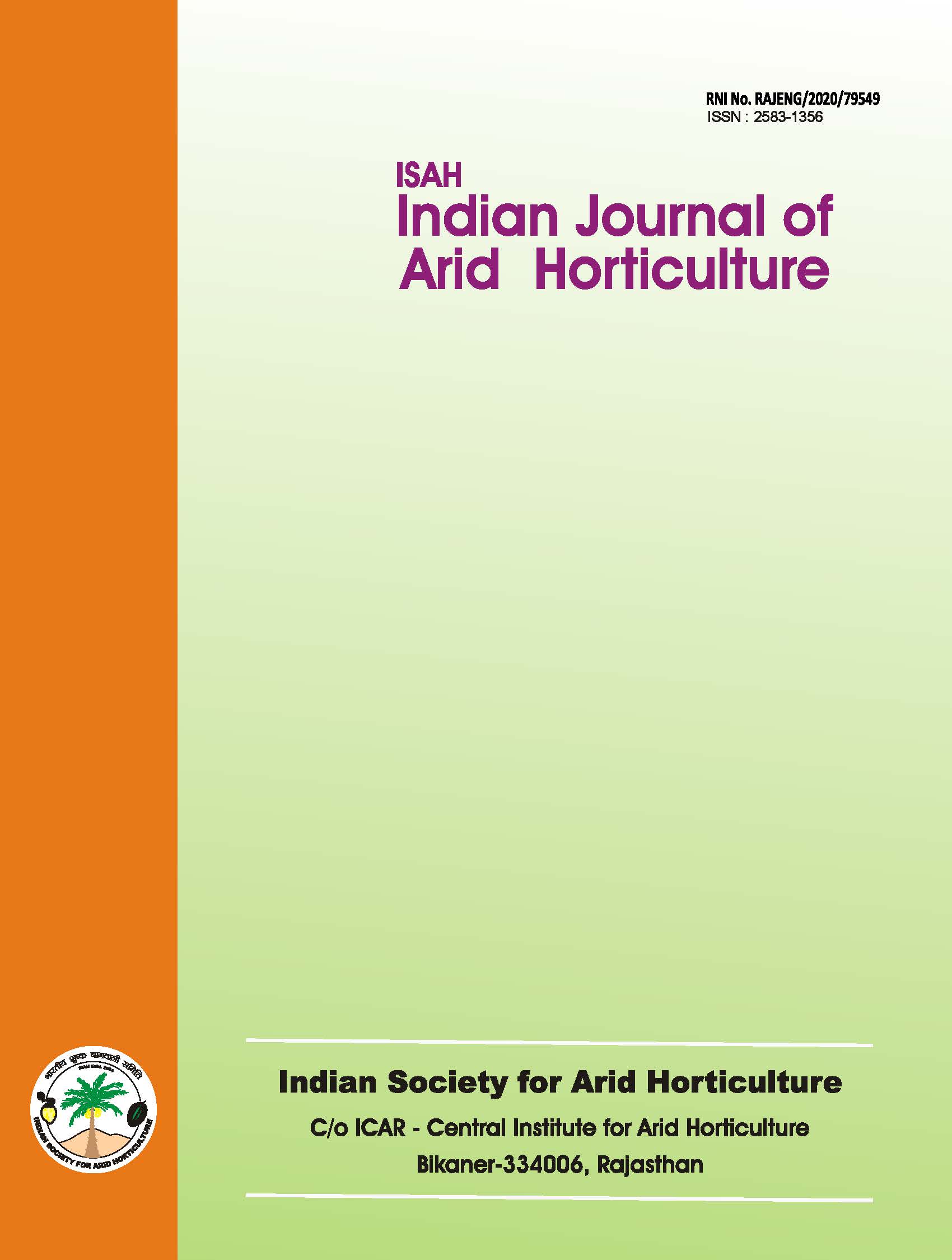Biological control of arid fruit diseases
Keywords:
Ambient temperature, physiological loss in weight, spoilage loss, economic life and respiration rateAbstract
Area of plantation of arid fruits is increasing every year under arid and semi-arid regions of the country. Fruit crops like ber; pomegranate, aonla, date palm and other minor fruits are mostly grown in water deficit areas. Among different production constraints in these crops, diseases are also concerned with yield and quality of fruits. For example, powdery mildew of ber can devastate whole orchards and fruit rots can trim down yield and quality of fruits. Leaf and fruit spots in pomegranate affect the foreign trade; rust in aonla results in poor quality of fruits in the absence of proper management practices in these crops. Low establishment of new plantation in date palm is mainly because of sucker rot in addition to fruit rot incited by common saprophytes. Despite, advancements in plant pathology and molecular plant pathology, much attempts have not been focused on etiology and management of arid zone fruits and therefore, presently a comprehensive information on biological control is discussed herewith.Downloads
References
Atika, A.H., Malika, C., Nacera, D. and Djilali, B. 1977. Date palm and Fusarium disease. VI. Microbiological activity of the rhizosphere of some cultivars of date palm (Phoenix dactylifera). Bulletin de la Société d'Histoire Naturelle de l'Afrique du Nord, 68(1-2): 3-35.
Benjama, A. 1994. Isolation of nonpathogenic bacterial contaminants of micropropagated date palms (Phoenix dactilyfera L.) and banana (Musa sp.) in Morocco. Phytobacteriology, 85: 89-96.
Chavan, S.N. and Dake, G.N. 2001. In vitro inhibition of Fusarium associated with wilt of pomegranate by rhizobacteria. Journal of Maharashtra Agricultural Universities, 26(3): 257-259.
Kumar, A., Bhansali, R.P. and Arya, H.C. 1978. A note on the occurrence of powdery mildew on ber (Ziziphus spp.) in Indian arid zone. Annals of Arid Zone, 17(3): 223-225.
Lamari, L. and Sabaou, N. 1993. Comparative study of the bacterial rhizosphere flora of two cultivars of date palms sensitive and resistant to fusariosis. Canadian Journal of Microbiology, 39(9): 874-881.
Mamatha, T., Lokesh, S. and Rai, V.R. 2000. Impact of seed mycoflora of forest tree seeds on seed quality and their management. Seed Research, 28(1): 59-67.
Mandhare, V.K. and Suryawanshi, A.V. 2003. Antagonistic effect of Bacillus thermophillus on some pathogens. Journal of Maharashtra Agricultural Universities, 28(3): 274-277.
Nallathambi, P. 2001. Investigations on symptomatology, physiology and management of ber (Ziziphus marutiana Lamk) fruit rots in Rajasthan. Ph.D. Thesis, Rajasthan College of Agriculture, Maharana Pratap University of Agriculture and Technology, Udaipur, pp. 196.
Nallathambi, P. and Thakore, B.B.L. 2002a. Biocontrol potential of Pseudomonas fluorescens against fruit rot pathogen of ber. In: Proceedings of the National Seminar on Role of Antimicrobials for Sustainable Horticulture, Indira Gandhi Agricultural University, Raipur, pp. 30-31.
Nallathambi, P. and Thakore, B.B.L. 2002b. Efficacy of Trichoderma isolates against fruit rot pathogen in ber. In: Proceedings of the National Seminar on Role of Antimicrobials for Sustainable Horticulture, Indira Gandhi Agricultural University, Raipur, p. 30.
Nallathambi, P. and Thakore, B.B.L. 2003. Combined efficacy of fluorescent Pseudomonads and fungicides on management of Alternaria alternata causing fruit rot of ber (Ziziphus mauritiana Lamk). In: Proceedings of the 6th International Workshop on Plant Growth Rhizobacteria, Indian Institute of Spices Research, Calicut, Kerala, pp. 301-302.
Nallathambi, P. and Umamaheswari, C. 2003. Biological management of ber powdery mildew. CIAH Newsletter, 2(2): p. 3.
Nallathambi, P., Umamaheswari, C., Joshi, H.K. and Dhandar, D.G. 2003a. Management of ber (Ziziphus mauritiana Lamk) powdery mildew using fluorescent Pseudomonads. In: Proceedings of the 6th International Workshop on Plant Growth Rhizobacteria, Indian Institute of Spices Research, Calicut, Kerala, pp. 184-187.
Nallathambi, P., Umamaheswari, C., Joshi, H.K. and Dhandar, D.G. 2003b. Evaluation of fluorescent Pseudomonads against virus diseases of mateera (Watermelon). In: Proceedings of the 6th International Workshop on Plant Growth Rhizobacteria, Indian Institute of Spices Research, Calicut, Kerala, pp. 181-184.
Oganyan, E.A. 1977. Antagonism of spore-forming bacteria to some pathogenic fungi of fruit and subtropical trees. Biologicheskii Zhurnal Armenii, 30(70): 68-71.
Sabaou, N., Amir, H. and Bounaga, D. 1980. Date palm and Fusarium disease. X. Numbers of rhizosphere actinomycetes; their antagonism against Fusarium oxysporum f. sp. albedinis. Annales de Phytopathologie, 12(3): 253-257.
Sedra, M.H. and Maslouhy, M.A. 1995. Fusarium wilt of date palm (bayoud). II. Inhibitory activity of filtrates of six antagonistic microorganisms isolated from Marrakech date palm grove soils towards Fusarium oxysporum f. sp. albedinis. Al-Awamia, 90: 1-8, 33.
Somasekhara, Y.M. 2002. Application of Bacillus subtilis in the management of pomegranate (Punica granatum Linn.) wilt (Ceratocystis fimbriata Ell. and Halst.) disease. Research on Crops, 3(1): 202-203.
Verma, R.K., Khatri, P.K. and Kunhikannan, C. 2000. Diversity of ground flora, soil microflora and fauna under Zizyphus mauritiana and Buchanania lanzan plantations on degraded land. Environment and Ecology, 18(2): 426-433.
Pusy, P.L. and Wilson, C.L. 1984. Post-harvest biological control of stone fruit brown rot by Bacillus subtilis. Plant Disease, 68: 753-756.
Mercer, R.C. and Papadopolous, S. 1990. Biological control of seed-borne diseases of linseed. Proceedings: Biocontrol of Pest and Diseases. Agriculture Food Science Centre, Belfast.

